Reflection Report: Mental Health Nursing and Teamwork Dynamics
VerifiedAdded on 2023/01/03
|12
|4231
|34
Report
AI Summary
This report presents a reflection on a mental health nursing module, utilizing the Gibbs reflective cycle to analyze learning experiences. The reflection details the acquisition of practical knowledge regarding inter-professional teamwork and collaborative practices within healthcare settings. It explores the application of Tuckman's theory of team development, highlighting the stages of team formation and the importance of effective communication, including the use of consistency and silence theories, in managing conflicts and fostering collaboration among diverse healthcare professionals such as doctors, nurses, and lab technicians. The report evaluates the impact of the module on the student's understanding of professional roles, values, and practices, emphasizing the significance of professional identity, patient care, and ethical considerations within the healthcare context. The student reflects on the positive aspects of the learning experience, including the development of practical skills through role-playing exercises, while also identifying areas for improvement, such as addressing conflicts within the team. The reflection underscores the importance of teamwork and communication in delivering high-quality patient care, aligning with the core values of healthcare professionals.
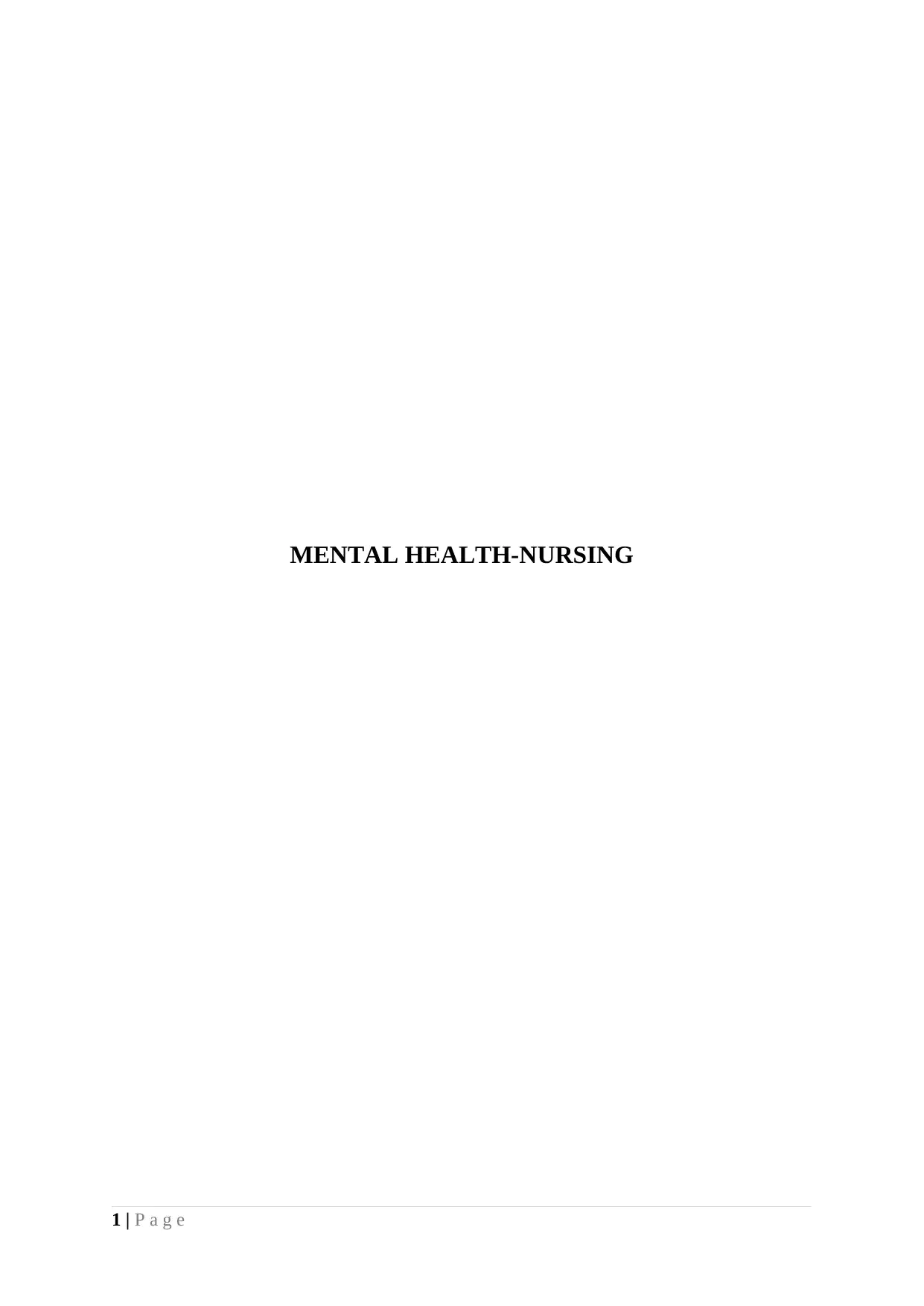
MENTAL HEALTH-NURSING
1 | P a g e
1 | P a g e
Paraphrase This Document
Need a fresh take? Get an instant paraphrase of this document with our AI Paraphraser
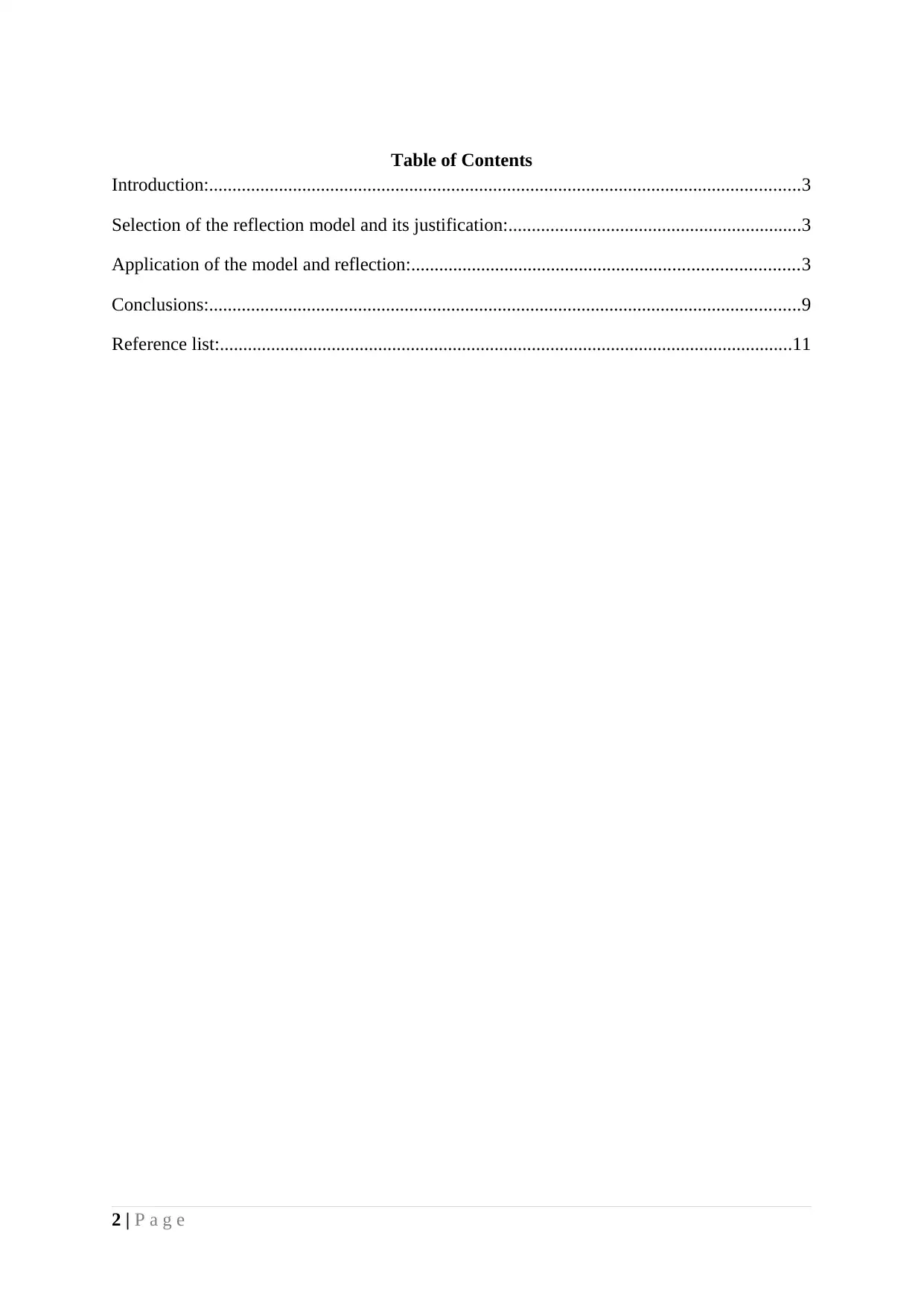
Table of Contents
Introduction:...............................................................................................................................3
Selection of the reflection model and its justification:...............................................................3
Application of the model and reflection:...................................................................................3
Conclusions:...............................................................................................................................9
Reference list:...........................................................................................................................11
2 | P a g e
Introduction:...............................................................................................................................3
Selection of the reflection model and its justification:...............................................................3
Application of the model and reflection:...................................................................................3
Conclusions:...............................................................................................................................9
Reference list:...........................................................................................................................11
2 | P a g e
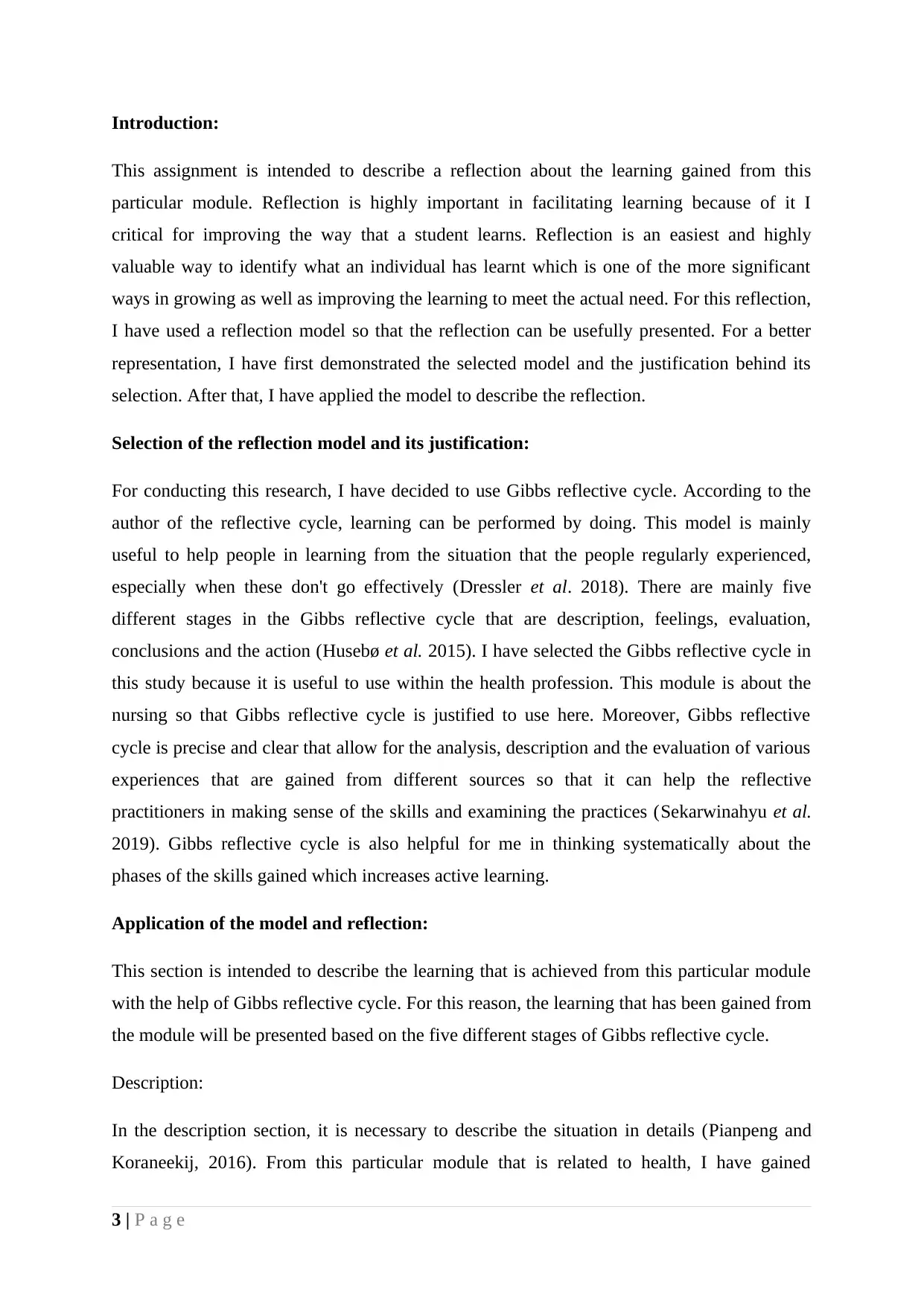
Introduction:
This assignment is intended to describe a reflection about the learning gained from this
particular module. Reflection is highly important in facilitating learning because of it I
critical for improving the way that a student learns. Reflection is an easiest and highly
valuable way to identify what an individual has learnt which is one of the more significant
ways in growing as well as improving the learning to meet the actual need. For this reflection,
I have used a reflection model so that the reflection can be usefully presented. For a better
representation, I have first demonstrated the selected model and the justification behind its
selection. After that, I have applied the model to describe the reflection.
Selection of the reflection model and its justification:
For conducting this research, I have decided to use Gibbs reflective cycle. According to the
author of the reflective cycle, learning can be performed by doing. This model is mainly
useful to help people in learning from the situation that the people regularly experienced,
especially when these don't go effectively (Dressler et al. 2018). There are mainly five
different stages in the Gibbs reflective cycle that are description, feelings, evaluation,
conclusions and the action (Husebø et al. 2015). I have selected the Gibbs reflective cycle in
this study because it is useful to use within the health profession. This module is about the
nursing so that Gibbs reflective cycle is justified to use here. Moreover, Gibbs reflective
cycle is precise and clear that allow for the analysis, description and the evaluation of various
experiences that are gained from different sources so that it can help the reflective
practitioners in making sense of the skills and examining the practices (Sekarwinahyu et al.
2019). Gibbs reflective cycle is also helpful for me in thinking systematically about the
phases of the skills gained which increases active learning.
Application of the model and reflection:
This section is intended to describe the learning that is achieved from this particular module
with the help of Gibbs reflective cycle. For this reason, the learning that has been gained from
the module will be presented based on the five different stages of Gibbs reflective cycle.
Description:
In the description section, it is necessary to describe the situation in details (Pianpeng and
Koraneekij, 2016). From this particular module that is related to health, I have gained
3 | P a g e
This assignment is intended to describe a reflection about the learning gained from this
particular module. Reflection is highly important in facilitating learning because of it I
critical for improving the way that a student learns. Reflection is an easiest and highly
valuable way to identify what an individual has learnt which is one of the more significant
ways in growing as well as improving the learning to meet the actual need. For this reflection,
I have used a reflection model so that the reflection can be usefully presented. For a better
representation, I have first demonstrated the selected model and the justification behind its
selection. After that, I have applied the model to describe the reflection.
Selection of the reflection model and its justification:
For conducting this research, I have decided to use Gibbs reflective cycle. According to the
author of the reflective cycle, learning can be performed by doing. This model is mainly
useful to help people in learning from the situation that the people regularly experienced,
especially when these don't go effectively (Dressler et al. 2018). There are mainly five
different stages in the Gibbs reflective cycle that are description, feelings, evaluation,
conclusions and the action (Husebø et al. 2015). I have selected the Gibbs reflective cycle in
this study because it is useful to use within the health profession. This module is about the
nursing so that Gibbs reflective cycle is justified to use here. Moreover, Gibbs reflective
cycle is precise and clear that allow for the analysis, description and the evaluation of various
experiences that are gained from different sources so that it can help the reflective
practitioners in making sense of the skills and examining the practices (Sekarwinahyu et al.
2019). Gibbs reflective cycle is also helpful for me in thinking systematically about the
phases of the skills gained which increases active learning.
Application of the model and reflection:
This section is intended to describe the learning that is achieved from this particular module
with the help of Gibbs reflective cycle. For this reason, the learning that has been gained from
the module will be presented based on the five different stages of Gibbs reflective cycle.
Description:
In the description section, it is necessary to describe the situation in details (Pianpeng and
Koraneekij, 2016). From this particular module that is related to health, I have gained
3 | P a g e
⊘ This is a preview!⊘
Do you want full access?
Subscribe today to unlock all pages.

Trusted by 1+ million students worldwide
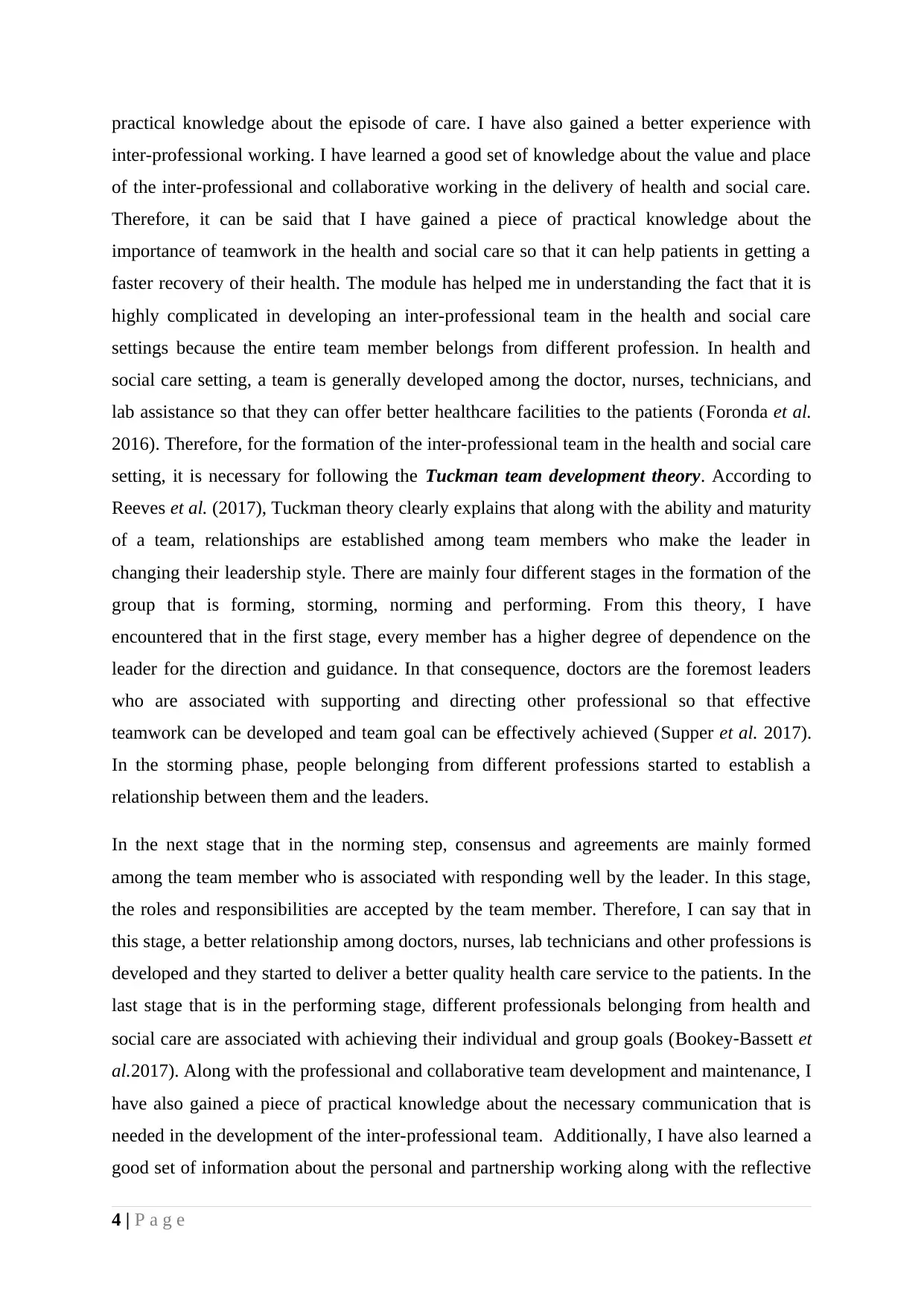
practical knowledge about the episode of care. I have also gained a better experience with
inter-professional working. I have learned a good set of knowledge about the value and place
of the inter-professional and collaborative working in the delivery of health and social care.
Therefore, it can be said that I have gained a piece of practical knowledge about the
importance of teamwork in the health and social care so that it can help patients in getting a
faster recovery of their health. The module has helped me in understanding the fact that it is
highly complicated in developing an inter-professional team in the health and social care
settings because the entire team member belongs from different profession. In health and
social care setting, a team is generally developed among the doctor, nurses, technicians, and
lab assistance so that they can offer better healthcare facilities to the patients (Foronda et al.
2016). Therefore, for the formation of the inter-professional team in the health and social care
setting, it is necessary for following the Tuckman team development theory. According to
Reeves et al. (2017), Tuckman theory clearly explains that along with the ability and maturity
of a team, relationships are established among team members who make the leader in
changing their leadership style. There are mainly four different stages in the formation of the
group that is forming, storming, norming and performing. From this theory, I have
encountered that in the first stage, every member has a higher degree of dependence on the
leader for the direction and guidance. In that consequence, doctors are the foremost leaders
who are associated with supporting and directing other professional so that effective
teamwork can be developed and team goal can be effectively achieved (Supper et al. 2017).
In the storming phase, people belonging from different professions started to establish a
relationship between them and the leaders.
In the next stage that in the norming step, consensus and agreements are mainly formed
among the team member who is associated with responding well by the leader. In this stage,
the roles and responsibilities are accepted by the team member. Therefore, I can say that in
this stage, a better relationship among doctors, nurses, lab technicians and other professions is
developed and they started to deliver a better quality health care service to the patients. In the
last stage that is in the performing stage, different professionals belonging from health and
social care are associated with achieving their individual and group goals (Bookey‐Bassett et
al.2017). Along with the professional and collaborative team development and maintenance, I
have also gained a piece of practical knowledge about the necessary communication that is
needed in the development of the inter-professional team. Additionally, I have also learned a
good set of information about the personal and partnership working along with the reflective
4 | P a g e
inter-professional working. I have learned a good set of knowledge about the value and place
of the inter-professional and collaborative working in the delivery of health and social care.
Therefore, it can be said that I have gained a piece of practical knowledge about the
importance of teamwork in the health and social care so that it can help patients in getting a
faster recovery of their health. The module has helped me in understanding the fact that it is
highly complicated in developing an inter-professional team in the health and social care
settings because the entire team member belongs from different profession. In health and
social care setting, a team is generally developed among the doctor, nurses, technicians, and
lab assistance so that they can offer better healthcare facilities to the patients (Foronda et al.
2016). Therefore, for the formation of the inter-professional team in the health and social care
setting, it is necessary for following the Tuckman team development theory. According to
Reeves et al. (2017), Tuckman theory clearly explains that along with the ability and maturity
of a team, relationships are established among team members who make the leader in
changing their leadership style. There are mainly four different stages in the formation of the
group that is forming, storming, norming and performing. From this theory, I have
encountered that in the first stage, every member has a higher degree of dependence on the
leader for the direction and guidance. In that consequence, doctors are the foremost leaders
who are associated with supporting and directing other professional so that effective
teamwork can be developed and team goal can be effectively achieved (Supper et al. 2017).
In the storming phase, people belonging from different professions started to establish a
relationship between them and the leaders.
In the next stage that in the norming step, consensus and agreements are mainly formed
among the team member who is associated with responding well by the leader. In this stage,
the roles and responsibilities are accepted by the team member. Therefore, I can say that in
this stage, a better relationship among doctors, nurses, lab technicians and other professions is
developed and they started to deliver a better quality health care service to the patients. In the
last stage that is in the performing stage, different professionals belonging from health and
social care are associated with achieving their individual and group goals (Bookey‐Bassett et
al.2017). Along with the professional and collaborative team development and maintenance, I
have also gained a piece of practical knowledge about the necessary communication that is
needed in the development of the inter-professional team. Additionally, I have also learned a
good set of information about the personal and partnership working along with the reflective
4 | P a g e
Paraphrase This Document
Need a fresh take? Get an instant paraphrase of this document with our AI Paraphraser
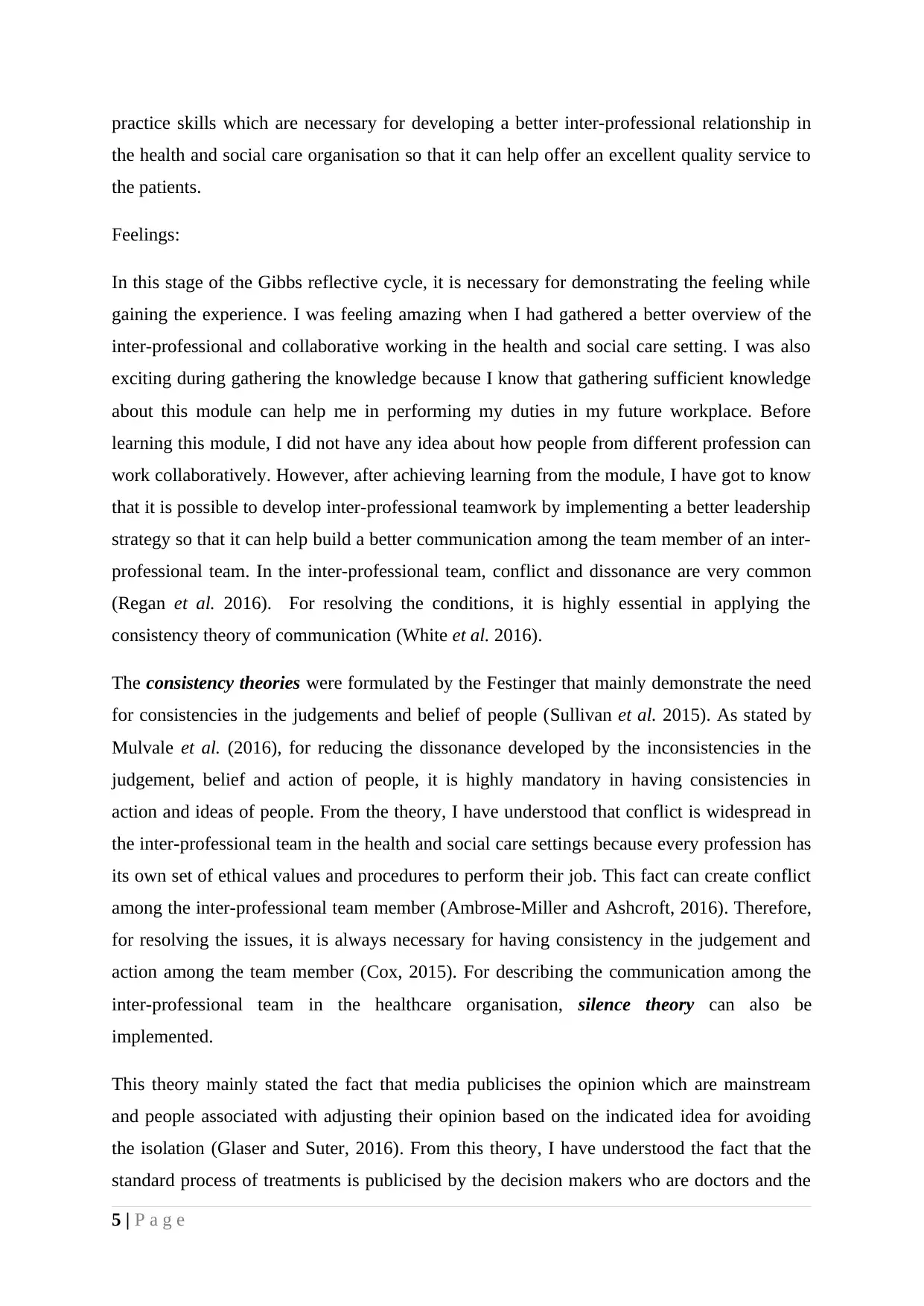
practice skills which are necessary for developing a better inter-professional relationship in
the health and social care organisation so that it can help offer an excellent quality service to
the patients.
Feelings:
In this stage of the Gibbs reflective cycle, it is necessary for demonstrating the feeling while
gaining the experience. I was feeling amazing when I had gathered a better overview of the
inter-professional and collaborative working in the health and social care setting. I was also
exciting during gathering the knowledge because I know that gathering sufficient knowledge
about this module can help me in performing my duties in my future workplace. Before
learning this module, I did not have any idea about how people from different profession can
work collaboratively. However, after achieving learning from the module, I have got to know
that it is possible to develop inter-professional teamwork by implementing a better leadership
strategy so that it can help build a better communication among the team member of an inter-
professional team. In the inter-professional team, conflict and dissonance are very common
(Regan et al. 2016). For resolving the conditions, it is highly essential in applying the
consistency theory of communication (White et al. 2016).
The consistency theories were formulated by the Festinger that mainly demonstrate the need
for consistencies in the judgements and belief of people (Sullivan et al. 2015). As stated by
Mulvale et al. (2016), for reducing the dissonance developed by the inconsistencies in the
judgement, belief and action of people, it is highly mandatory in having consistencies in
action and ideas of people. From the theory, I have understood that conflict is widespread in
the inter-professional team in the health and social care settings because every profession has
its own set of ethical values and procedures to perform their job. This fact can create conflict
among the inter-professional team member (Ambrose-Miller and Ashcroft, 2016). Therefore,
for resolving the issues, it is always necessary for having consistency in the judgement and
action among the team member (Cox, 2015). For describing the communication among the
inter-professional team in the healthcare organisation, silence theory can also be
implemented.
This theory mainly stated the fact that media publicises the opinion which are mainstream
and people associated with adjusting their opinion based on the indicated idea for avoiding
the isolation (Glaser and Suter, 2016). From this theory, I have understood the fact that the
standard process of treatments is publicised by the decision makers who are doctors and the
5 | P a g e
the health and social care organisation so that it can help offer an excellent quality service to
the patients.
Feelings:
In this stage of the Gibbs reflective cycle, it is necessary for demonstrating the feeling while
gaining the experience. I was feeling amazing when I had gathered a better overview of the
inter-professional and collaborative working in the health and social care setting. I was also
exciting during gathering the knowledge because I know that gathering sufficient knowledge
about this module can help me in performing my duties in my future workplace. Before
learning this module, I did not have any idea about how people from different profession can
work collaboratively. However, after achieving learning from the module, I have got to know
that it is possible to develop inter-professional teamwork by implementing a better leadership
strategy so that it can help build a better communication among the team member of an inter-
professional team. In the inter-professional team, conflict and dissonance are very common
(Regan et al. 2016). For resolving the conditions, it is highly essential in applying the
consistency theory of communication (White et al. 2016).
The consistency theories were formulated by the Festinger that mainly demonstrate the need
for consistencies in the judgements and belief of people (Sullivan et al. 2015). As stated by
Mulvale et al. (2016), for reducing the dissonance developed by the inconsistencies in the
judgement, belief and action of people, it is highly mandatory in having consistencies in
action and ideas of people. From the theory, I have understood that conflict is widespread in
the inter-professional team in the health and social care settings because every profession has
its own set of ethical values and procedures to perform their job. This fact can create conflict
among the inter-professional team member (Ambrose-Miller and Ashcroft, 2016). Therefore,
for resolving the issues, it is always necessary for having consistency in the judgement and
action among the team member (Cox, 2015). For describing the communication among the
inter-professional team in the healthcare organisation, silence theory can also be
implemented.
This theory mainly stated the fact that media publicises the opinion which are mainstream
and people associated with adjusting their opinion based on the indicated idea for avoiding
the isolation (Glaser and Suter, 2016). From this theory, I have understood the fact that the
standard process of treatments is publicised by the decision makers who are doctors and the
5 | P a g e
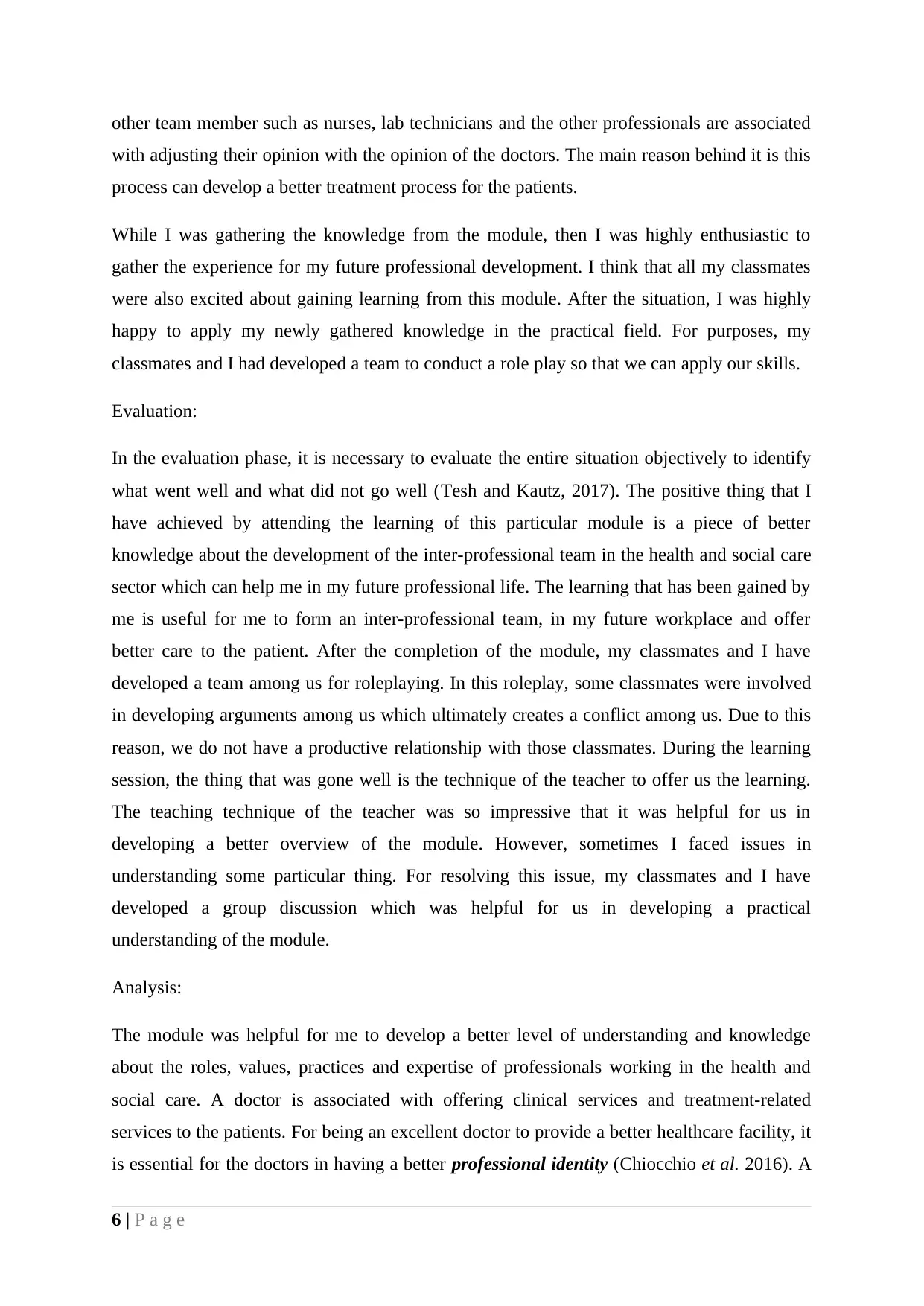
other team member such as nurses, lab technicians and the other professionals are associated
with adjusting their opinion with the opinion of the doctors. The main reason behind it is this
process can develop a better treatment process for the patients.
While I was gathering the knowledge from the module, then I was highly enthusiastic to
gather the experience for my future professional development. I think that all my classmates
were also excited about gaining learning from this module. After the situation, I was highly
happy to apply my newly gathered knowledge in the practical field. For purposes, my
classmates and I had developed a team to conduct a role play so that we can apply our skills.
Evaluation:
In the evaluation phase, it is necessary to evaluate the entire situation objectively to identify
what went well and what did not go well (Tesh and Kautz, 2017). The positive thing that I
have achieved by attending the learning of this particular module is a piece of better
knowledge about the development of the inter-professional team in the health and social care
sector which can help me in my future professional life. The learning that has been gained by
me is useful for me to form an inter-professional team, in my future workplace and offer
better care to the patient. After the completion of the module, my classmates and I have
developed a team among us for roleplaying. In this roleplay, some classmates were involved
in developing arguments among us which ultimately creates a conflict among us. Due to this
reason, we do not have a productive relationship with those classmates. During the learning
session, the thing that was gone well is the technique of the teacher to offer us the learning.
The teaching technique of the teacher was so impressive that it was helpful for us in
developing a better overview of the module. However, sometimes I faced issues in
understanding some particular thing. For resolving this issue, my classmates and I have
developed a group discussion which was helpful for us in developing a practical
understanding of the module.
Analysis:
The module was helpful for me to develop a better level of understanding and knowledge
about the roles, values, practices and expertise of professionals working in the health and
social care. A doctor is associated with offering clinical services and treatment-related
services to the patients. For being an excellent doctor to provide a better healthcare facility, it
is essential for the doctors in having a better professional identity (Chiocchio et al. 2016). A
6 | P a g e
with adjusting their opinion with the opinion of the doctors. The main reason behind it is this
process can develop a better treatment process for the patients.
While I was gathering the knowledge from the module, then I was highly enthusiastic to
gather the experience for my future professional development. I think that all my classmates
were also excited about gaining learning from this module. After the situation, I was highly
happy to apply my newly gathered knowledge in the practical field. For purposes, my
classmates and I had developed a team to conduct a role play so that we can apply our skills.
Evaluation:
In the evaluation phase, it is necessary to evaluate the entire situation objectively to identify
what went well and what did not go well (Tesh and Kautz, 2017). The positive thing that I
have achieved by attending the learning of this particular module is a piece of better
knowledge about the development of the inter-professional team in the health and social care
sector which can help me in my future professional life. The learning that has been gained by
me is useful for me to form an inter-professional team, in my future workplace and offer
better care to the patient. After the completion of the module, my classmates and I have
developed a team among us for roleplaying. In this roleplay, some classmates were involved
in developing arguments among us which ultimately creates a conflict among us. Due to this
reason, we do not have a productive relationship with those classmates. During the learning
session, the thing that was gone well is the technique of the teacher to offer us the learning.
The teaching technique of the teacher was so impressive that it was helpful for us in
developing a better overview of the module. However, sometimes I faced issues in
understanding some particular thing. For resolving this issue, my classmates and I have
developed a group discussion which was helpful for us in developing a practical
understanding of the module.
Analysis:
The module was helpful for me to develop a better level of understanding and knowledge
about the roles, values, practices and expertise of professionals working in the health and
social care. A doctor is associated with offering clinical services and treatment-related
services to the patients. For being an excellent doctor to provide a better healthcare facility, it
is essential for the doctors in having a better professional identity (Chiocchio et al. 2016). A
6 | P a g e
⊘ This is a preview!⊘
Do you want full access?
Subscribe today to unlock all pages.

Trusted by 1+ million students worldwide
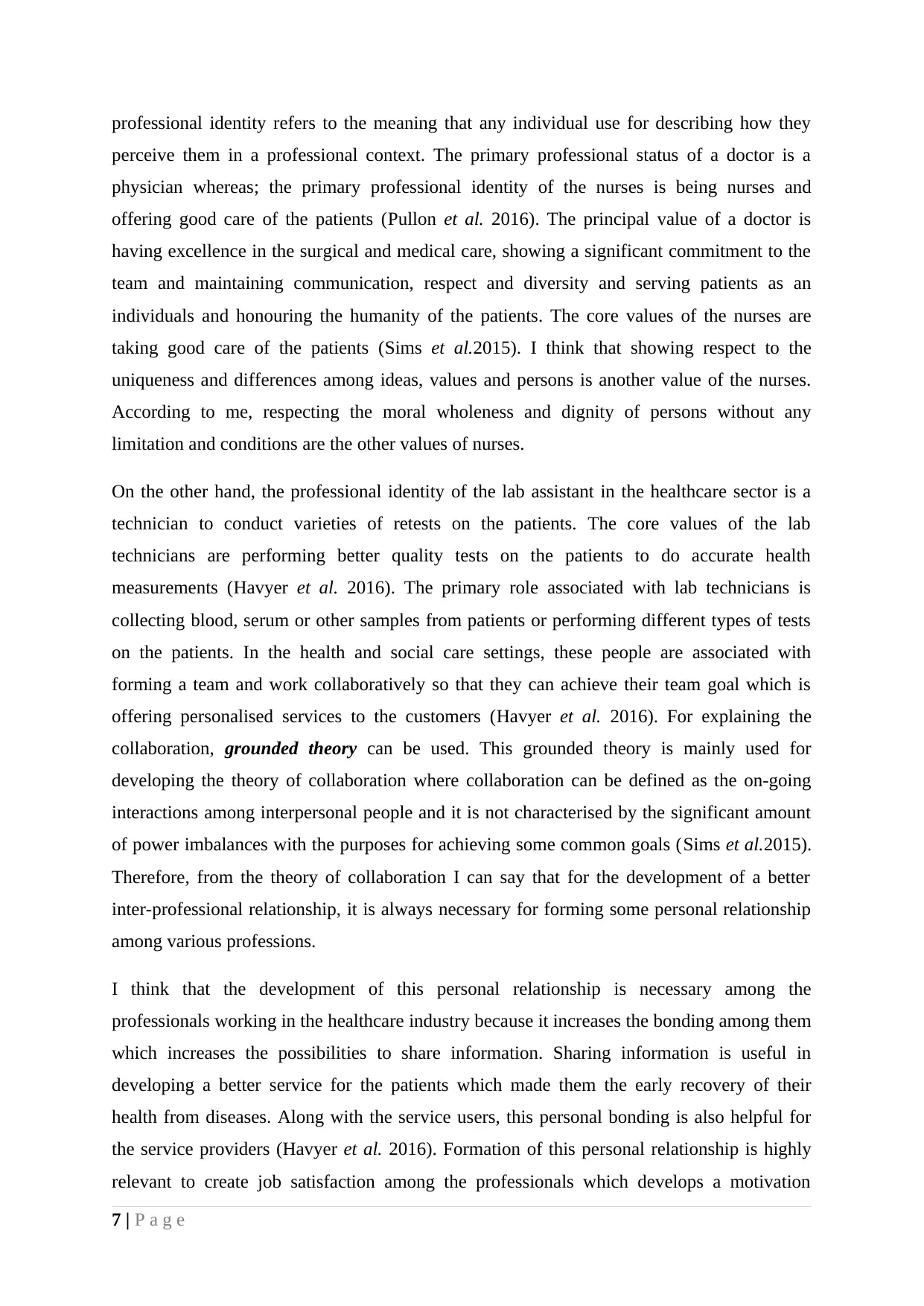
professional identity refers to the meaning that any individual use for describing how they
perceive them in a professional context. The primary professional status of a doctor is a
physician whereas; the primary professional identity of the nurses is being nurses and
offering good care of the patients (Pullon et al. 2016). The principal value of a doctor is
having excellence in the surgical and medical care, showing a significant commitment to the
team and maintaining communication, respect and diversity and serving patients as an
individuals and honouring the humanity of the patients. The core values of the nurses are
taking good care of the patients (Sims et al.2015). I think that showing respect to the
uniqueness and differences among ideas, values and persons is another value of the nurses.
According to me, respecting the moral wholeness and dignity of persons without any
limitation and conditions are the other values of nurses.
On the other hand, the professional identity of the lab assistant in the healthcare sector is a
technician to conduct varieties of retests on the patients. The core values of the lab
technicians are performing better quality tests on the patients to do accurate health
measurements (Havyer et al. 2016). The primary role associated with lab technicians is
collecting blood, serum or other samples from patients or performing different types of tests
on the patients. In the health and social care settings, these people are associated with
forming a team and work collaboratively so that they can achieve their team goal which is
offering personalised services to the customers (Havyer et al. 2016). For explaining the
collaboration, grounded theory can be used. This grounded theory is mainly used for
developing the theory of collaboration where collaboration can be defined as the on-going
interactions among interpersonal people and it is not characterised by the significant amount
of power imbalances with the purposes for achieving some common goals (Sims et al.2015).
Therefore, from the theory of collaboration I can say that for the development of a better
inter-professional relationship, it is always necessary for forming some personal relationship
among various professions.
I think that the development of this personal relationship is necessary among the
professionals working in the healthcare industry because it increases the bonding among them
which increases the possibilities to share information. Sharing information is useful in
developing a better service for the patients which made them the early recovery of their
health from diseases. Along with the service users, this personal bonding is also helpful for
the service providers (Havyer et al. 2016). Formation of this personal relationship is highly
relevant to create job satisfaction among the professionals which develops a motivation
7 | P a g e
perceive them in a professional context. The primary professional status of a doctor is a
physician whereas; the primary professional identity of the nurses is being nurses and
offering good care of the patients (Pullon et al. 2016). The principal value of a doctor is
having excellence in the surgical and medical care, showing a significant commitment to the
team and maintaining communication, respect and diversity and serving patients as an
individuals and honouring the humanity of the patients. The core values of the nurses are
taking good care of the patients (Sims et al.2015). I think that showing respect to the
uniqueness and differences among ideas, values and persons is another value of the nurses.
According to me, respecting the moral wholeness and dignity of persons without any
limitation and conditions are the other values of nurses.
On the other hand, the professional identity of the lab assistant in the healthcare sector is a
technician to conduct varieties of retests on the patients. The core values of the lab
technicians are performing better quality tests on the patients to do accurate health
measurements (Havyer et al. 2016). The primary role associated with lab technicians is
collecting blood, serum or other samples from patients or performing different types of tests
on the patients. In the health and social care settings, these people are associated with
forming a team and work collaboratively so that they can achieve their team goal which is
offering personalised services to the customers (Havyer et al. 2016). For explaining the
collaboration, grounded theory can be used. This grounded theory is mainly used for
developing the theory of collaboration where collaboration can be defined as the on-going
interactions among interpersonal people and it is not characterised by the significant amount
of power imbalances with the purposes for achieving some common goals (Sims et al.2015).
Therefore, from the theory of collaboration I can say that for the development of a better
inter-professional relationship, it is always necessary for forming some personal relationship
among various professions.
I think that the development of this personal relationship is necessary among the
professionals working in the healthcare industry because it increases the bonding among them
which increases the possibilities to share information. Sharing information is useful in
developing a better service for the patients which made them the early recovery of their
health from diseases. Along with the service users, this personal bonding is also helpful for
the service providers (Havyer et al. 2016). Formation of this personal relationship is highly
relevant to create job satisfaction among the professionals which develops a motivation
7 | P a g e
Paraphrase This Document
Need a fresh take? Get an instant paraphrase of this document with our AI Paraphraser
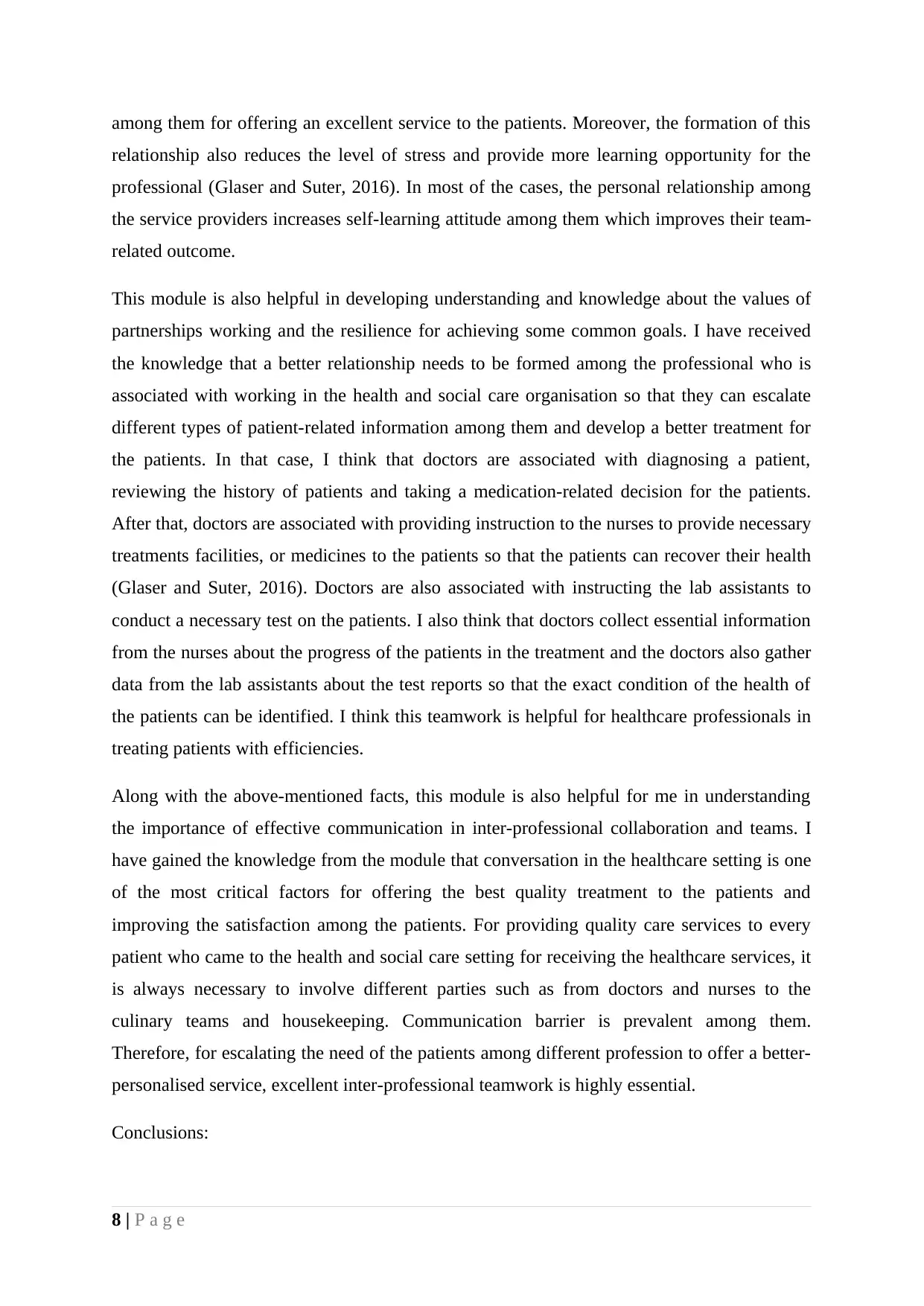
among them for offering an excellent service to the patients. Moreover, the formation of this
relationship also reduces the level of stress and provide more learning opportunity for the
professional (Glaser and Suter, 2016). In most of the cases, the personal relationship among
the service providers increases self-learning attitude among them which improves their team-
related outcome.
This module is also helpful in developing understanding and knowledge about the values of
partnerships working and the resilience for achieving some common goals. I have received
the knowledge that a better relationship needs to be formed among the professional who is
associated with working in the health and social care organisation so that they can escalate
different types of patient-related information among them and develop a better treatment for
the patients. In that case, I think that doctors are associated with diagnosing a patient,
reviewing the history of patients and taking a medication-related decision for the patients.
After that, doctors are associated with providing instruction to the nurses to provide necessary
treatments facilities, or medicines to the patients so that the patients can recover their health
(Glaser and Suter, 2016). Doctors are also associated with instructing the lab assistants to
conduct a necessary test on the patients. I also think that doctors collect essential information
from the nurses about the progress of the patients in the treatment and the doctors also gather
data from the lab assistants about the test reports so that the exact condition of the health of
the patients can be identified. I think this teamwork is helpful for healthcare professionals in
treating patients with efficiencies.
Along with the above-mentioned facts, this module is also helpful for me in understanding
the importance of effective communication in inter-professional collaboration and teams. I
have gained the knowledge from the module that conversation in the healthcare setting is one
of the most critical factors for offering the best quality treatment to the patients and
improving the satisfaction among the patients. For providing quality care services to every
patient who came to the health and social care setting for receiving the healthcare services, it
is always necessary to involve different parties such as from doctors and nurses to the
culinary teams and housekeeping. Communication barrier is prevalent among them.
Therefore, for escalating the need of the patients among different profession to offer a better-
personalised service, excellent inter-professional teamwork is highly essential.
Conclusions:
8 | P a g e
relationship also reduces the level of stress and provide more learning opportunity for the
professional (Glaser and Suter, 2016). In most of the cases, the personal relationship among
the service providers increases self-learning attitude among them which improves their team-
related outcome.
This module is also helpful in developing understanding and knowledge about the values of
partnerships working and the resilience for achieving some common goals. I have received
the knowledge that a better relationship needs to be formed among the professional who is
associated with working in the health and social care organisation so that they can escalate
different types of patient-related information among them and develop a better treatment for
the patients. In that case, I think that doctors are associated with diagnosing a patient,
reviewing the history of patients and taking a medication-related decision for the patients.
After that, doctors are associated with providing instruction to the nurses to provide necessary
treatments facilities, or medicines to the patients so that the patients can recover their health
(Glaser and Suter, 2016). Doctors are also associated with instructing the lab assistants to
conduct a necessary test on the patients. I also think that doctors collect essential information
from the nurses about the progress of the patients in the treatment and the doctors also gather
data from the lab assistants about the test reports so that the exact condition of the health of
the patients can be identified. I think this teamwork is helpful for healthcare professionals in
treating patients with efficiencies.
Along with the above-mentioned facts, this module is also helpful for me in understanding
the importance of effective communication in inter-professional collaboration and teams. I
have gained the knowledge from the module that conversation in the healthcare setting is one
of the most critical factors for offering the best quality treatment to the patients and
improving the satisfaction among the patients. For providing quality care services to every
patient who came to the health and social care setting for receiving the healthcare services, it
is always necessary to involve different parties such as from doctors and nurses to the
culinary teams and housekeeping. Communication barrier is prevalent among them.
Therefore, for escalating the need of the patients among different profession to offer a better-
personalised service, excellent inter-professional teamwork is highly essential.
Conclusions:
8 | P a g e
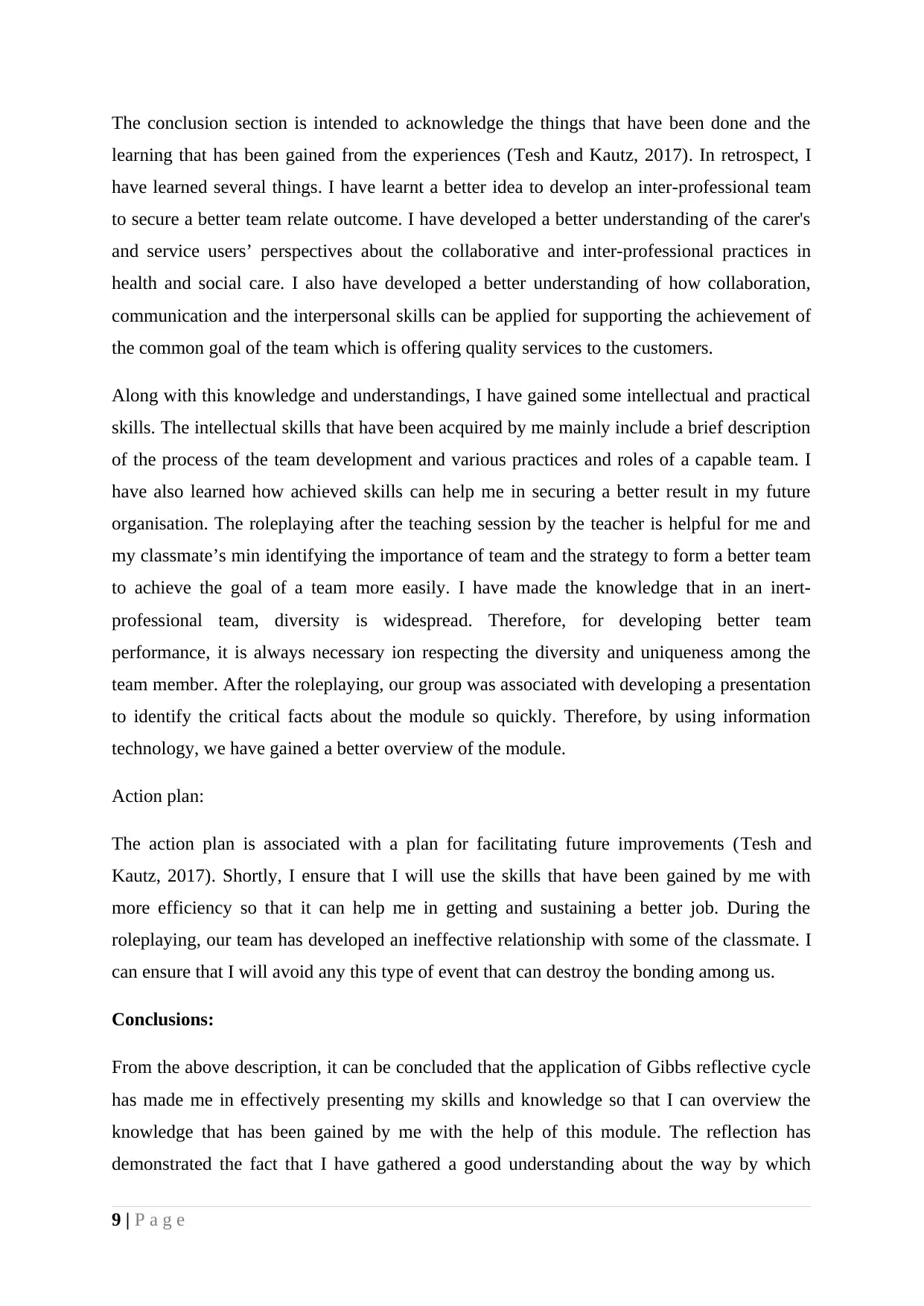
The conclusion section is intended to acknowledge the things that have been done and the
learning that has been gained from the experiences (Tesh and Kautz, 2017). In retrospect, I
have learned several things. I have learnt a better idea to develop an inter-professional team
to secure a better team relate outcome. I have developed a better understanding of the carer's
and service users’ perspectives about the collaborative and inter-professional practices in
health and social care. I also have developed a better understanding of how collaboration,
communication and the interpersonal skills can be applied for supporting the achievement of
the common goal of the team which is offering quality services to the customers.
Along with this knowledge and understandings, I have gained some intellectual and practical
skills. The intellectual skills that have been acquired by me mainly include a brief description
of the process of the team development and various practices and roles of a capable team. I
have also learned how achieved skills can help me in securing a better result in my future
organisation. The roleplaying after the teaching session by the teacher is helpful for me and
my classmate’s min identifying the importance of team and the strategy to form a better team
to achieve the goal of a team more easily. I have made the knowledge that in an inert-
professional team, diversity is widespread. Therefore, for developing better team
performance, it is always necessary ion respecting the diversity and uniqueness among the
team member. After the roleplaying, our group was associated with developing a presentation
to identify the critical facts about the module so quickly. Therefore, by using information
technology, we have gained a better overview of the module.
Action plan:
The action plan is associated with a plan for facilitating future improvements (Tesh and
Kautz, 2017). Shortly, I ensure that I will use the skills that have been gained by me with
more efficiency so that it can help me in getting and sustaining a better job. During the
roleplaying, our team has developed an ineffective relationship with some of the classmate. I
can ensure that I will avoid any this type of event that can destroy the bonding among us.
Conclusions:
From the above description, it can be concluded that the application of Gibbs reflective cycle
has made me in effectively presenting my skills and knowledge so that I can overview the
knowledge that has been gained by me with the help of this module. The reflection has
demonstrated the fact that I have gathered a good understanding about the way by which
9 | P a g e
learning that has been gained from the experiences (Tesh and Kautz, 2017). In retrospect, I
have learned several things. I have learnt a better idea to develop an inter-professional team
to secure a better team relate outcome. I have developed a better understanding of the carer's
and service users’ perspectives about the collaborative and inter-professional practices in
health and social care. I also have developed a better understanding of how collaboration,
communication and the interpersonal skills can be applied for supporting the achievement of
the common goal of the team which is offering quality services to the customers.
Along with this knowledge and understandings, I have gained some intellectual and practical
skills. The intellectual skills that have been acquired by me mainly include a brief description
of the process of the team development and various practices and roles of a capable team. I
have also learned how achieved skills can help me in securing a better result in my future
organisation. The roleplaying after the teaching session by the teacher is helpful for me and
my classmate’s min identifying the importance of team and the strategy to form a better team
to achieve the goal of a team more easily. I have made the knowledge that in an inert-
professional team, diversity is widespread. Therefore, for developing better team
performance, it is always necessary ion respecting the diversity and uniqueness among the
team member. After the roleplaying, our group was associated with developing a presentation
to identify the critical facts about the module so quickly. Therefore, by using information
technology, we have gained a better overview of the module.
Action plan:
The action plan is associated with a plan for facilitating future improvements (Tesh and
Kautz, 2017). Shortly, I ensure that I will use the skills that have been gained by me with
more efficiency so that it can help me in getting and sustaining a better job. During the
roleplaying, our team has developed an ineffective relationship with some of the classmate. I
can ensure that I will avoid any this type of event that can destroy the bonding among us.
Conclusions:
From the above description, it can be concluded that the application of Gibbs reflective cycle
has made me in effectively presenting my skills and knowledge so that I can overview the
knowledge that has been gained by me with the help of this module. The reflection has
demonstrated the fact that I have gathered a good understanding about the way by which
9 | P a g e
⊘ This is a preview!⊘
Do you want full access?
Subscribe today to unlock all pages.

Trusted by 1+ million students worldwide
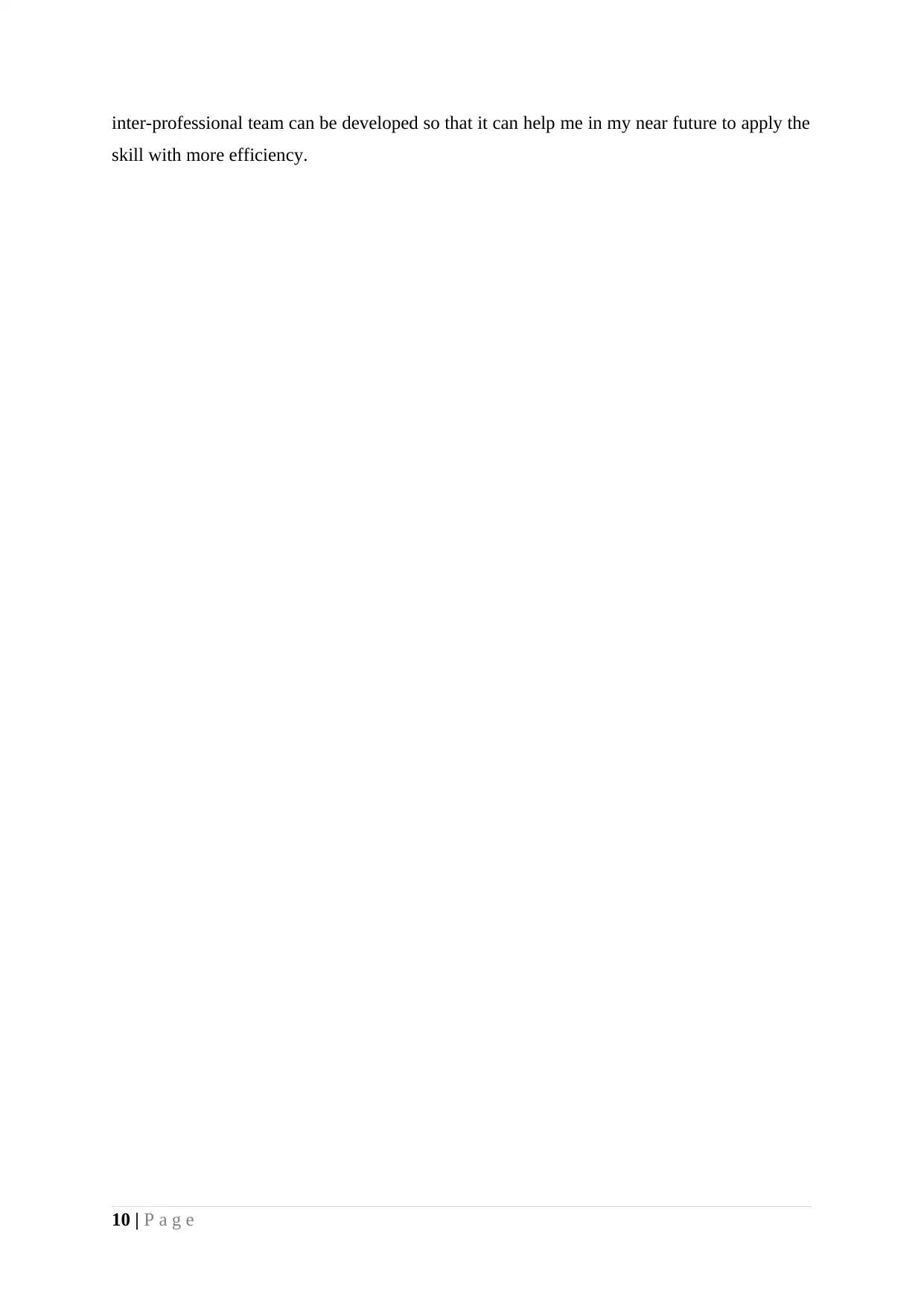
inter-professional team can be developed so that it can help me in my near future to apply the
skill with more efficiency.
10 | P a g e
skill with more efficiency.
10 | P a g e
Paraphrase This Document
Need a fresh take? Get an instant paraphrase of this document with our AI Paraphraser
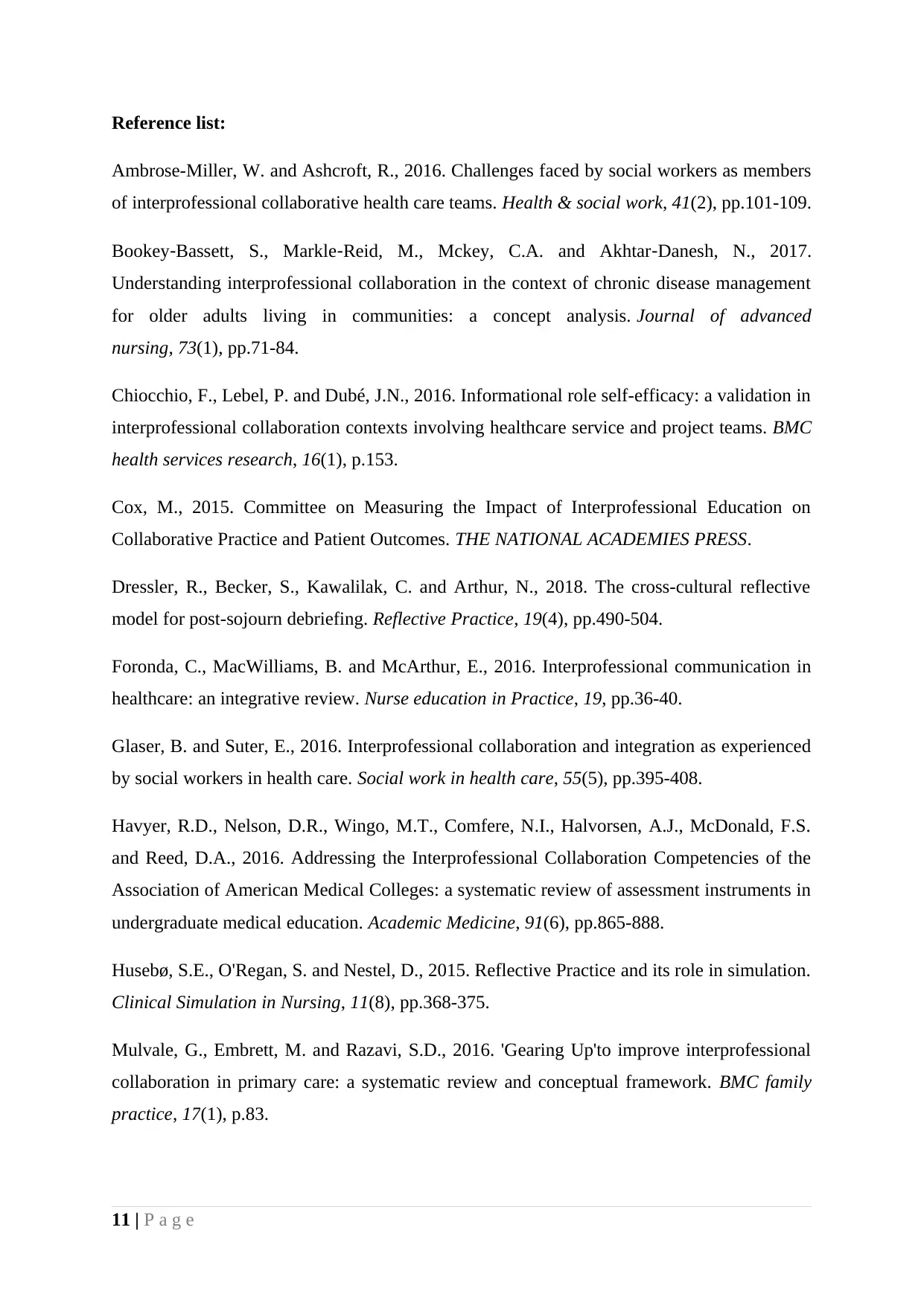
Reference list:
Ambrose-Miller, W. and Ashcroft, R., 2016. Challenges faced by social workers as members
of interprofessional collaborative health care teams. Health & social work, 41(2), pp.101-109.
Bookey‐Bassett, S., Markle‐Reid, M., Mckey, C.A. and Akhtar‐Danesh, N., 2017.
Understanding interprofessional collaboration in the context of chronic disease management
for older adults living in communities: a concept analysis. Journal of advanced
nursing, 73(1), pp.71-84.
Chiocchio, F., Lebel, P. and Dubé, J.N., 2016. Informational role self-efficacy: a validation in
interprofessional collaboration contexts involving healthcare service and project teams. BMC
health services research, 16(1), p.153.
Cox, M., 2015. Committee on Measuring the Impact of Interprofessional Education on
Collaborative Practice and Patient Outcomes. THE NATIONAL ACADEMIES PRESS.
Dressler, R., Becker, S., Kawalilak, C. and Arthur, N., 2018. The cross-cultural reflective
model for post-sojourn debriefing. Reflective Practice, 19(4), pp.490-504.
Foronda, C., MacWilliams, B. and McArthur, E., 2016. Interprofessional communication in
healthcare: an integrative review. Nurse education in Practice, 19, pp.36-40.
Glaser, B. and Suter, E., 2016. Interprofessional collaboration and integration as experienced
by social workers in health care. Social work in health care, 55(5), pp.395-408.
Havyer, R.D., Nelson, D.R., Wingo, M.T., Comfere, N.I., Halvorsen, A.J., McDonald, F.S.
and Reed, D.A., 2016. Addressing the Interprofessional Collaboration Competencies of the
Association of American Medical Colleges: a systematic review of assessment instruments in
undergraduate medical education. Academic Medicine, 91(6), pp.865-888.
Husebø, S.E., O'Regan, S. and Nestel, D., 2015. Reflective Practice and its role in simulation.
Clinical Simulation in Nursing, 11(8), pp.368-375.
Mulvale, G., Embrett, M. and Razavi, S.D., 2016. 'Gearing Up'to improve interprofessional
collaboration in primary care: a systematic review and conceptual framework. BMC family
practice, 17(1), p.83.
11 | P a g e
Ambrose-Miller, W. and Ashcroft, R., 2016. Challenges faced by social workers as members
of interprofessional collaborative health care teams. Health & social work, 41(2), pp.101-109.
Bookey‐Bassett, S., Markle‐Reid, M., Mckey, C.A. and Akhtar‐Danesh, N., 2017.
Understanding interprofessional collaboration in the context of chronic disease management
for older adults living in communities: a concept analysis. Journal of advanced
nursing, 73(1), pp.71-84.
Chiocchio, F., Lebel, P. and Dubé, J.N., 2016. Informational role self-efficacy: a validation in
interprofessional collaboration contexts involving healthcare service and project teams. BMC
health services research, 16(1), p.153.
Cox, M., 2015. Committee on Measuring the Impact of Interprofessional Education on
Collaborative Practice and Patient Outcomes. THE NATIONAL ACADEMIES PRESS.
Dressler, R., Becker, S., Kawalilak, C. and Arthur, N., 2018. The cross-cultural reflective
model for post-sojourn debriefing. Reflective Practice, 19(4), pp.490-504.
Foronda, C., MacWilliams, B. and McArthur, E., 2016. Interprofessional communication in
healthcare: an integrative review. Nurse education in Practice, 19, pp.36-40.
Glaser, B. and Suter, E., 2016. Interprofessional collaboration and integration as experienced
by social workers in health care. Social work in health care, 55(5), pp.395-408.
Havyer, R.D., Nelson, D.R., Wingo, M.T., Comfere, N.I., Halvorsen, A.J., McDonald, F.S.
and Reed, D.A., 2016. Addressing the Interprofessional Collaboration Competencies of the
Association of American Medical Colleges: a systematic review of assessment instruments in
undergraduate medical education. Academic Medicine, 91(6), pp.865-888.
Husebø, S.E., O'Regan, S. and Nestel, D., 2015. Reflective Practice and its role in simulation.
Clinical Simulation in Nursing, 11(8), pp.368-375.
Mulvale, G., Embrett, M. and Razavi, S.D., 2016. 'Gearing Up'to improve interprofessional
collaboration in primary care: a systematic review and conceptual framework. BMC family
practice, 17(1), p.83.
11 | P a g e
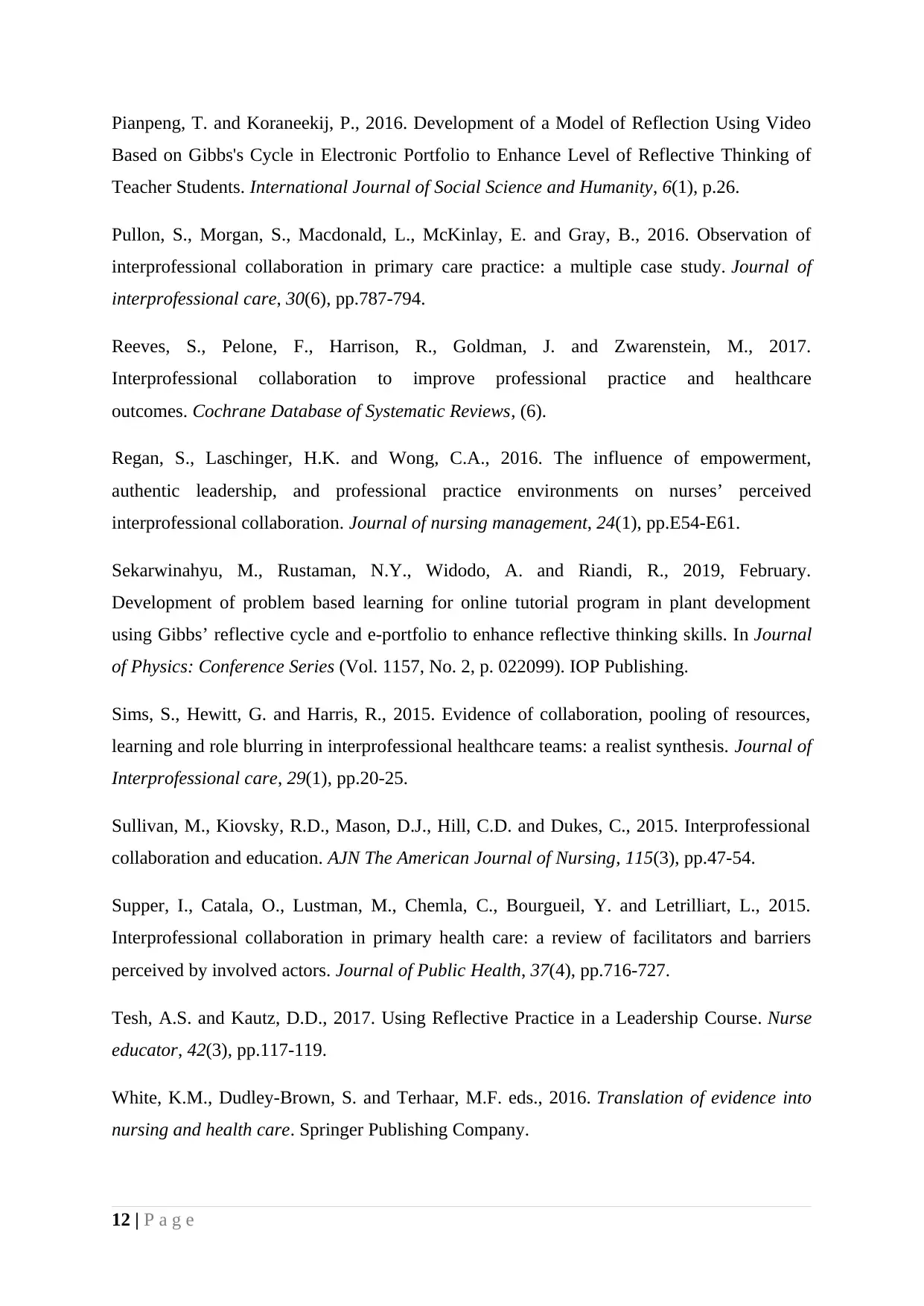
Pianpeng, T. and Koraneekij, P., 2016. Development of a Model of Reflection Using Video
Based on Gibbs's Cycle in Electronic Portfolio to Enhance Level of Reflective Thinking of
Teacher Students. International Journal of Social Science and Humanity, 6(1), p.26.
Pullon, S., Morgan, S., Macdonald, L., McKinlay, E. and Gray, B., 2016. Observation of
interprofessional collaboration in primary care practice: a multiple case study. Journal of
interprofessional care, 30(6), pp.787-794.
Reeves, S., Pelone, F., Harrison, R., Goldman, J. and Zwarenstein, M., 2017.
Interprofessional collaboration to improve professional practice and healthcare
outcomes. Cochrane Database of Systematic Reviews, (6).
Regan, S., Laschinger, H.K. and Wong, C.A., 2016. The influence of empowerment,
authentic leadership, and professional practice environments on nurses’ perceived
interprofessional collaboration. Journal of nursing management, 24(1), pp.E54-E61.
Sekarwinahyu, M., Rustaman, N.Y., Widodo, A. and Riandi, R., 2019, February.
Development of problem based learning for online tutorial program in plant development
using Gibbs’ reflective cycle and e-portfolio to enhance reflective thinking skills. In Journal
of Physics: Conference Series (Vol. 1157, No. 2, p. 022099). IOP Publishing.
Sims, S., Hewitt, G. and Harris, R., 2015. Evidence of collaboration, pooling of resources,
learning and role blurring in interprofessional healthcare teams: a realist synthesis. Journal of
Interprofessional care, 29(1), pp.20-25.
Sullivan, M., Kiovsky, R.D., Mason, D.J., Hill, C.D. and Dukes, C., 2015. Interprofessional
collaboration and education. AJN The American Journal of Nursing, 115(3), pp.47-54.
Supper, I., Catala, O., Lustman, M., Chemla, C., Bourgueil, Y. and Letrilliart, L., 2015.
Interprofessional collaboration in primary health care: a review of facilitators and barriers
perceived by involved actors. Journal of Public Health, 37(4), pp.716-727.
Tesh, A.S. and Kautz, D.D., 2017. Using Reflective Practice in a Leadership Course. Nurse
educator, 42(3), pp.117-119.
White, K.M., Dudley-Brown, S. and Terhaar, M.F. eds., 2016. Translation of evidence into
nursing and health care. Springer Publishing Company.
12 | P a g e
Based on Gibbs's Cycle in Electronic Portfolio to Enhance Level of Reflective Thinking of
Teacher Students. International Journal of Social Science and Humanity, 6(1), p.26.
Pullon, S., Morgan, S., Macdonald, L., McKinlay, E. and Gray, B., 2016. Observation of
interprofessional collaboration in primary care practice: a multiple case study. Journal of
interprofessional care, 30(6), pp.787-794.
Reeves, S., Pelone, F., Harrison, R., Goldman, J. and Zwarenstein, M., 2017.
Interprofessional collaboration to improve professional practice and healthcare
outcomes. Cochrane Database of Systematic Reviews, (6).
Regan, S., Laschinger, H.K. and Wong, C.A., 2016. The influence of empowerment,
authentic leadership, and professional practice environments on nurses’ perceived
interprofessional collaboration. Journal of nursing management, 24(1), pp.E54-E61.
Sekarwinahyu, M., Rustaman, N.Y., Widodo, A. and Riandi, R., 2019, February.
Development of problem based learning for online tutorial program in plant development
using Gibbs’ reflective cycle and e-portfolio to enhance reflective thinking skills. In Journal
of Physics: Conference Series (Vol. 1157, No. 2, p. 022099). IOP Publishing.
Sims, S., Hewitt, G. and Harris, R., 2015. Evidence of collaboration, pooling of resources,
learning and role blurring in interprofessional healthcare teams: a realist synthesis. Journal of
Interprofessional care, 29(1), pp.20-25.
Sullivan, M., Kiovsky, R.D., Mason, D.J., Hill, C.D. and Dukes, C., 2015. Interprofessional
collaboration and education. AJN The American Journal of Nursing, 115(3), pp.47-54.
Supper, I., Catala, O., Lustman, M., Chemla, C., Bourgueil, Y. and Letrilliart, L., 2015.
Interprofessional collaboration in primary health care: a review of facilitators and barriers
perceived by involved actors. Journal of Public Health, 37(4), pp.716-727.
Tesh, A.S. and Kautz, D.D., 2017. Using Reflective Practice in a Leadership Course. Nurse
educator, 42(3), pp.117-119.
White, K.M., Dudley-Brown, S. and Terhaar, M.F. eds., 2016. Translation of evidence into
nursing and health care. Springer Publishing Company.
12 | P a g e
⊘ This is a preview!⊘
Do you want full access?
Subscribe today to unlock all pages.

Trusted by 1+ million students worldwide
1 out of 12
Related Documents
Your All-in-One AI-Powered Toolkit for Academic Success.
+13062052269
info@desklib.com
Available 24*7 on WhatsApp / Email
![[object Object]](/_next/static/media/star-bottom.7253800d.svg)
Unlock your academic potential
Copyright © 2020–2025 A2Z Services. All Rights Reserved. Developed and managed by ZUCOL.





